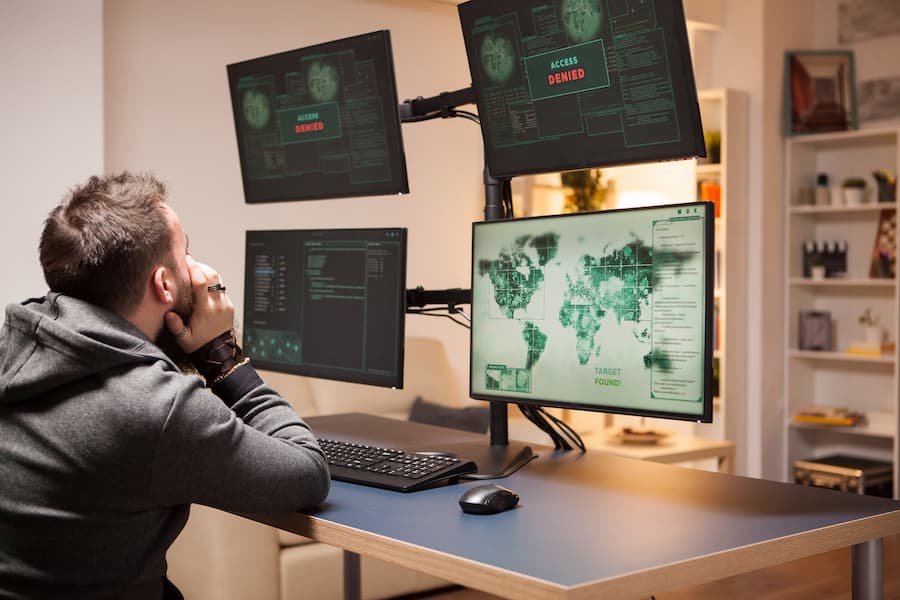Why Network Threat Detection is Crucial for Cybersecurity
Network Threat Detection
Network threat detection is a critical component of modern cybersecurity strategies. With the increasing sophistication of cyber attacks, it is essential for organizations to have robust mechanisms to detect and respond to threats in real-time. Network threat detection involves monitoring network traffic for suspicious activities, identifying potential threats, and initiating appropriate response actions to mitigate the impact of these threats.
This article will provide a comprehensive overview of network threat detection, including its importance, key components, techniques, tools, and how to implement an effective threat detection program. By understanding these aspects, organizations can enhance their cybersecurity posture and protect their sensitive data and network infrastructure from malicious activities.
The Basics of Network Threat Detection
What is Network Threat Detection?
Network threat detection refers to the process of identifying and responding to potential security threats within a network. This involves the continuous monitoring of network traffic to detect anomalies and suspicious activities that may indicate a cyber threat. Key terms related to network threat detection include:

- Threat: Any potential danger that can exploit a vulnerability to breach security and cause harm.
- Detection: The process of identifying and recognizing potential threats.
- Response: Actions taken to mitigate the impact of identified threats.
- Network: A collection of interconnected devices and systems that share data and resources.
Network threat detection is a proactive approach to cybersecurity, aiming to identify threats before they can cause significant damage.
Why Network Threat Detection is Crucial for Cybersecurity
Cyber threats are more prevalent and sophisticated than ever. Effective threat detection and response are essential for maintaining the security and integrity of an organization’s network. The importance of network threat detection in cybersecurity includes:
- Early Detection: Identifying threats early can prevent significant damage and data breaches.
- Minimizing Impact: Prompt response to detected threats can reduce the potential impact on the organization.
- Protecting Sensitive Data: Ensuring the security of sensitive information and preventing unauthorized access.
- Maintaining Business Continuity: Preventing disruptions to business operations caused by cyber attacks.
Effective threat detection can significantly enhance an organization’s overall cybersecurity posture, making it a crucial aspect of any security strategy.
Components of Network Threat Detection
Types of Threat Detection
Different types of threat detection mechanisms are used to monitor and protect network environments. Key types include:
- Endpoint Detection and Response (EDR): Focuses on monitoring and securing endpoints (e.g., computers, mobile devices) to detect and respond to threats.
- Network Detection and Response (NDR): Involves monitoring network traffic to identify and respond to threats across the entire network.
- Intrusion Detection Systems (IDS): Analyze network traffic for signs of known threats and anomalies.
Each type of threat detection has its strengths and can be integrated to provide comprehensive protection.
Key Technologies in Threat Detection
Various technologies are employed in threat detection to enhance the accuracy and efficiency of identifying potential threats:
- Detection Systems and Tools: Use advanced algorithms and signatures to detect known and unknown threats.
- Advanced Threat Detection Technologies: Leverage machine learning and artificial intelligence to analyze patterns and behaviors indicative of threats.
- Role of Machine Learning and Analytics: Machine learning models can learn from historical data to predict and identify new threats, while analytics help in understanding and correlating threat patterns.
These technologies enable organizations to stay ahead of evolving cyber threats and improve their detection capabilities.
Techniques and Tools for Effective Threat Detection

Detection and Response Techniques
Effective threat detection and response require a combination of techniques to identify and mitigate threats:
- Proactive Threat Hunting: Involves actively searching for potential threats within the network, rather than relying solely on automated systems.
- Automated Threat Detection: Utilizes automated systems to continuously monitor network traffic and alert security teams of potential threats.
- Network Traffic Analysis: Analyzes network traffic patterns to identify anomalies and suspicious activities that may indicate a threat.
These techniques ensure a comprehensive approach to threat detection, combining human expertise with automated systems.
Threat Detection Tools and Software
A variety of tools and software are available to assist organizations in threat detection and response:
- Overview of Threat Detection Tools and Software: Tools like SIEM (Security Information and Event Management) systems, antivirus software, and specialized threat detection solutions.
- Features of Effective Threat Detection and Response Tools: Real-time monitoring, automated alerting, integration with other security tools, and user-friendly interfaces.
- Integration of Antivirus Software and Intrusion Detection Systems: Combining traditional antivirus software with modern intrusion detection systems for layered security.
Choosing the right tools and software is crucial for effective threat detection and response.
Implementing a Network Threat Detection Program
Developing a Comprehensive Threat Detection Program
Implementing an effective threat detection program involves several steps:
- Steps to Implement a Threat Detection Program:
- Assessing the organization’s current security posture.
- Identifying key assets and potential threats.
- Selecting appropriate detection tools and technologies.
- Developing and enforcing security policies and procedures.
- Best Practices for Network Security:
- Regularly updating and patching systems.
- Conducting regular security assessments and audits.
- Training employees on security awareness and best practices.
- Continuous Threat Monitoring and Response Efforts: Ensuring ongoing monitoring and timely response to detected threats to minimize impact.
A well-structured threat detection program is essential for maintaining robust network security.
Role of Threat Intelligence
Threat intelligence plays a crucial role in enhancing threat detection and response capabilities:
- Importance of Advanced Threat Intelligence: Provides insights into emerging threats and attack vectors, enabling proactive defense.
- Integrating Threat Intelligence into Detection and Response: Using threat intelligence feeds to inform detection systems and improve accuracy.
Incorporating threat intelligence into threat detection strategies helps organizations stay ahead of evolving threats.
Advanced Threat Detection and Response Strategies
Advanced Threat Detection Techniques
In the ever-evolving landscape of cybersecurity, advanced threat detection techniques are crucial for identifying and mitigating sophisticated cyber threats. Some of the most effective techniques include:
- Machine Learning and Behavioral Analysis:
- Machine Learning: Utilizing algorithms that learn from historical data to detect patterns and anomalies indicative of cyber threats. These systems can adapt to new threats over time, improving their accuracy.
- Behavioral Analysis: Analyzing the behavior of users and systems within the network to identify deviations from normal activities, which may indicate a potential threat.
- Analyzing Raw Network Telemetry:
- Network Telemetry: Collecting and analyzing raw data from network devices, such as routers and switches, to identify unusual patterns and potential security threats. This data can provide insights into network health and security.
- Using Threat Database Feeds:
- Threat Intelligence Feeds: Integrating external threat intelligence feeds that provide up-to-date information on known threats, vulnerabilities, and attack vectors. This helps in proactively defending against emerging threats.
These advanced techniques enhance the ability to detect and respond to sophisticated cyber threats, ensuring a robust defense mechanism.
Effective Threat Detection and Response Capabilities
Enhancing threat detection and response capabilities involves improving various aspects of the security infrastructure:
- Enhancing Detection Capabilities:
- Real-time Monitoring: Implementing systems that provide continuous, real-time monitoring of network traffic to identify and respond to threats immediately.
- Correlation and Analysis: Using advanced analytics to correlate data from different sources, providing a comprehensive view of the threat landscape.
- Improving Response Actions and Incident Response:
- Automated Response: Leveraging automation to initiate predefined response actions upon detecting a threat, reducing the time to mitigate potential damage.
- Incident Response Plans: Developing and maintaining robust incident response plans that outline the steps to be taken in the event of a security breach.
By enhancing detection and response capabilities, organizations can minimize the impact of cyber threats and improve their overall security posture.
Managed Detection and Response (MDR)

What is Managed Detection and Response?
Managed Detection and Response (MDR) is a service that provides organizations with advanced threat detection and response capabilities through a third-party provider. MDR services typically include:
- Continuous Monitoring: 24/7 monitoring of network traffic and security events by a team of experts.
- Threat Intelligence and Analysis: Access to advanced threat intelligence and analytics to identify and respond to threats.
- Incident Response Support: Expert support and guidance in responding to and mitigating security incidents.
MDR services are designed to enhance an organization’s security capabilities by providing access to specialized expertise and advanced technologies.
Selecting an MDR Service Provider
Choosing the right MDR service provider is critical for ensuring effective threat detection and response. Key criteria to consider include:
- Expertise and Experience: The provider’s experience in the cybersecurity industry and their expertise in threat detection and response.
- Technology and Tools: The advanced technologies and tools used by the provider to detect and respond to threats.
- Service Level Agreements (SLAs): Clear SLAs that define the scope of services, response times, and performance metrics.
- Integration and Compatibility: The ability of the MDR service to integrate with existing security infrastructure and tools.
Selecting a reputable MDR provider can significantly enhance an organization’s security posture and provide peace of mind.
Addressing Common Challenges in Network Threat Detection
Challenges in Implementing Threat Detection
Implementing effective threat detection can be challenging due to various factors:
- Complexity of Networks: Modern networks are complex and diverse, making it difficult to monitor and secure all endpoints and devices.
- Volume of Data: The sheer volume of network traffic and security events can overwhelm detection systems and security teams.
- Evolving Threat Landscape: Cyber threats are constantly evolving, requiring continuous updates to detection tools and techniques.
Understanding and addressing these challenges is crucial for successful threat detection.
Improving Threat Detection Capabilities
Organizations can enhance their threat detection capabilities by focusing on key areas:
- Enhancing the Effectiveness of Detection Tools:
- Regular Updates: Ensuring that detection tools and systems are regularly updated with the latest threat intelligence and signatures.
- Customization: Customizing detection rules and policies to align with the specific needs and risk profile of the organization.
- Training and Equipping Security Teams:
- Ongoing Training: Providing continuous training and education to security teams to keep them updated on the latest threats and detection techniques.
- Advanced Tools: Equipping security teams with advanced tools and technologies to enhance their detection and response capabilities.
By addressing these areas, organizations can improve their ability to detect and respond to cyber threats effectively.
The Future of Network Threat Detection
Trends and Innovations in Threat Detection
The field of threat detection is continuously evolving, with new trends and innovations emerging:
- Emerging Technologies and Future Trends:
- Artificial Intelligence (AI): The use of AI in threat detection is increasing, enabling more accurate and efficient identification of threats.
- IoT Security: As the number of IoT devices grows, securing these devices and their connections becomes critical.
- Zero Trust Security: Implementing zero trust principles to ensure that all network traffic is treated as potentially malicious until verified.
These trends and innovations are shaping the future of network threat detection, making it more effective and resilient.
Preparing for Future Threats
Organizations must be proactive in preparing for future threats by adopting forward-thinking strategies:
- Strategies for Staying Ahead of Potential Threats:
- Continuous Improvement: Regularly reviewing and improving threat detection and response strategies to adapt to the evolving threat landscape.
- Collaboration: Collaborating with industry peers, threat intelligence providers, and cybersecurity experts to stay informed about emerging threats.
- Importance of Continuous Improvement in Threat Detection:
- Regular Assessments: Conducting regular security assessments and audits to identify and address vulnerabilities.
- Adopting Best Practices: Staying updated on industry best practices and incorporating them into the organization’s security strategy.
By preparing for future threats, organizations can enhance their resilience and ability to defend against cyber attacks.
What People May Also Ask
What is the difference between threat detection and response?
Threat detection involves identifying potential security threats within a network, while threat response involves taking actions to mitigate and neutralize these threats. Detection focuses on identifying anomalies and suspicious activities, while response focuses on addressing the identified threats to minimize their impact.
How does machine learning enhance threat detection?
Machine learning enhances threat detection by analyzing large volumes of data to identify patterns and anomalies indicative of cyber threats. These algorithms can learn from historical data and adapt to new threats over time, improving the accuracy and efficiency of threat detection.
What are the best tools for network threat detection?
Some of the best tools for network threat detection include Security Information and Event Management (SIEM) systems, Endpoint Detection and Response (EDR) tools, Network Detection and Response (NDR) solutions, and advanced threat intelligence platforms. These tools provide comprehensive monitoring and analysis capabilities to detect and respond to threats effectively.
Why is threat intelligence crucial in threat detection?
Threat intelligence provides valuable insights into emerging threats, vulnerabilities, and attack vectors. By integrating threat intelligence into threat detection systems, organizations can proactively defend against new threats and improve their overall security posture.
What are the common challenges in network threat detection?
Common challenges in network threat detection include the complexity of modern networks, the volume of network traffic and security events, and the constantly evolving threat landscape. Addressing these challenges requires advanced tools, continuous updates, and a proactive approach to threat detection and response.
Conclusion
As cyber threats continue to evolve, organizations must prioritize continuous improvement in their threat detection and response capabilities. By adopting advanced technologies, leveraging threat intelligence, and collaborating with industry experts, organizations can enhance their cybersecurity posture and protect their network infrastructure from malicious activities.
Implementing robust network threat detection strategies ensures a proactive defense against cyber threats, safeguarding sensitive data and maintaining business continuity.
By following this detailed guide, organizations can build a comprehensive and effective network threat detection program that aligns with best practices and industry standards.
You can contact us by phone, email, or by visiting our offices:
- Phone: (386) 261-8323
- Email: contact@smarttechfl.com
- Address: 771 Fentress Blvd. #10, Daytona Beach, FL 32114












